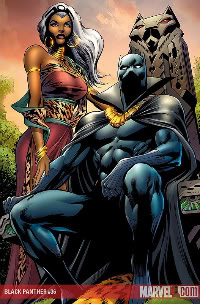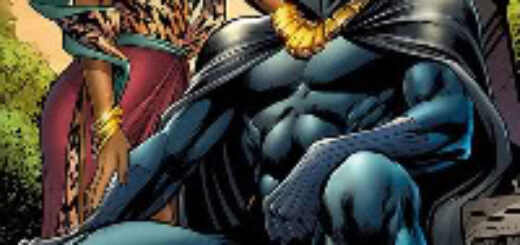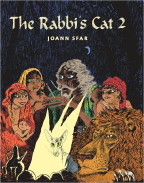The Weekly Haul: Reviews for May 23, 2008
Kudos to Marvel, who blew the pants off the competition in this week’s batch of issues, with an unprecedented four books being so good I have to list them all as tied for the top spot. And, surprise surprise, none of them were Skrullapalooza ’08 tie-ins.
Superheroes aside, a good mix of indies came out as well, making for a well rounded week that I’ll count as an early birthday present to yours truly.
 Book(s) of the Week — While these four Marvel books are all essentially equals, the pole position goes to Black Panther #36
Book(s) of the Week — While these four Marvel books are all essentially equals, the pole position goes to Black Panther #36. Now, I’ve long been something of a Reggie Hudlin hater, but he packs so much story into this issue without making it feel overloaded that it reads like a pre-Bendis Era comic. Killmonger – who makes a surprisingly good villain – rallies a destitute African nation around him in a way that truly captures the continent’s actual unrest. Meanwhile, we finally see the Storm-BP marriage addressed in a believable way, some intense fighting and the line of the week: "He’s already the Mole Man! What more could we do to him?"
Over in Ghost Rider #23, Jason Aaron follows last issue’s big buildup with a huge explosion (literally), and a storyline that perfectly depicts just how tortured Johnny Blaze really is. The art, by Roland Boschi, continues to shine, all scratchy and intense.
Captain America #38 makes the cut as another flawless entry from Ed Brubaker and Steve Epting, with special credit for an entirely plausible and non-Skrullish explanation to the mysterious Steve Rogers that Sharon found last go-round. Meanwhile, Bucky continues to gain his sea legs as the new Cap and the Red Skull’s plans meet political reality.
Lastly but not leastly, Peter David wraps up his Arcade storyline in X-Factor #31, which pulls readers deeply into the looming destruction of Mutanttown with the little emotional moments David is so good at. He also lets Arcade continue to be a relentlessly entertaining villain and makes this team of non-heroes truly heroic.
The Runners Up:
Scalped #17 — I’ve always been on the fence about this series, which has gone back and forth between too action-heavy and too slow. This issue strikes a solid balance as the community buries Dash’s mother and he finally lets himself mourn.
Robin #174 — The best from DC this week, as Robin and Batman figure out the identity of the new hero muddying Gotham’s waters. I won’t spoil it here, but it’s a true surprise that doesn’t seem TOO contrived. The real highlight is the realistic way Chuck Dixon captures everyone’s emotional response to the big news.




 Here at ComicMix, we’re traditionalists that believe summer actually starts on Memorial Day weekend, no matter what movies premiere in early May. So, with the official start of grilling season, may we humbly recommend that you do so with a Munden’s Bar
Here at ComicMix, we’re traditionalists that believe summer actually starts on Memorial Day weekend, no matter what movies premiere in early May. So, with the official start of grilling season, may we humbly recommend that you do so with a Munden’s Bar  Joann Sfar, one of the major lights of the current European graphic novel scene, has written or collaborated on more than one hundred books, but probably his most famous and acclaimed work is the original [[[The Rabbi’s Cat]]], which won the prestigious Jury Prize at the Festival International de la BD d’Angouleme (Angouleme International Comics Festival).
Joann Sfar, one of the major lights of the current European graphic novel scene, has written or collaborated on more than one hundred books, but probably his most famous and acclaimed work is the original [[[The Rabbi’s Cat]]], which won the prestigious Jury Prize at the Festival International de la BD d’Angouleme (Angouleme International Comics Festival). The “Dungeon” series has gotten so full of stories, so complicated, that there’s a diagram on the back of this book to explain how all of the sub-series relate to each other.
The “Dungeon” series has gotten so full of stories, so complicated, that there’s a diagram on the back of this book to explain how all of the sub-series relate to each other. In a previous edition of
In a previous edition of  Oregon has become the latest state to garner the national spotlight in this Democratic Presidential campaign "silly season." Just about every liberal blog I read had effusive reports of the huge turnout at last weekend’s rally for Barack Obama in Portland’s Waterfront Park. Now me, I can’t think of Oregon without thinking of two things: the annual
Oregon has become the latest state to garner the national spotlight in this Democratic Presidential campaign "silly season." Just about every liberal blog I read had effusive reports of the huge turnout at last weekend’s rally for Barack Obama in Portland’s Waterfront Park. Now me, I can’t think of Oregon without thinking of two things: the annual 
 This day began like the others all have, here at my computer. I heard the familiar startup sound of my Mac, saw the comforting image of my wallpaper and then opened up my e-mail.
This day began like the others all have, here at my computer. I heard the familiar startup sound of my Mac, saw the comforting image of my wallpaper and then opened up my e-mail. Neil Gaiman has been too busy lately to write much for comics unless it’s an event — like
Neil Gaiman has been too busy lately to write much for comics unless it’s an event — like 








